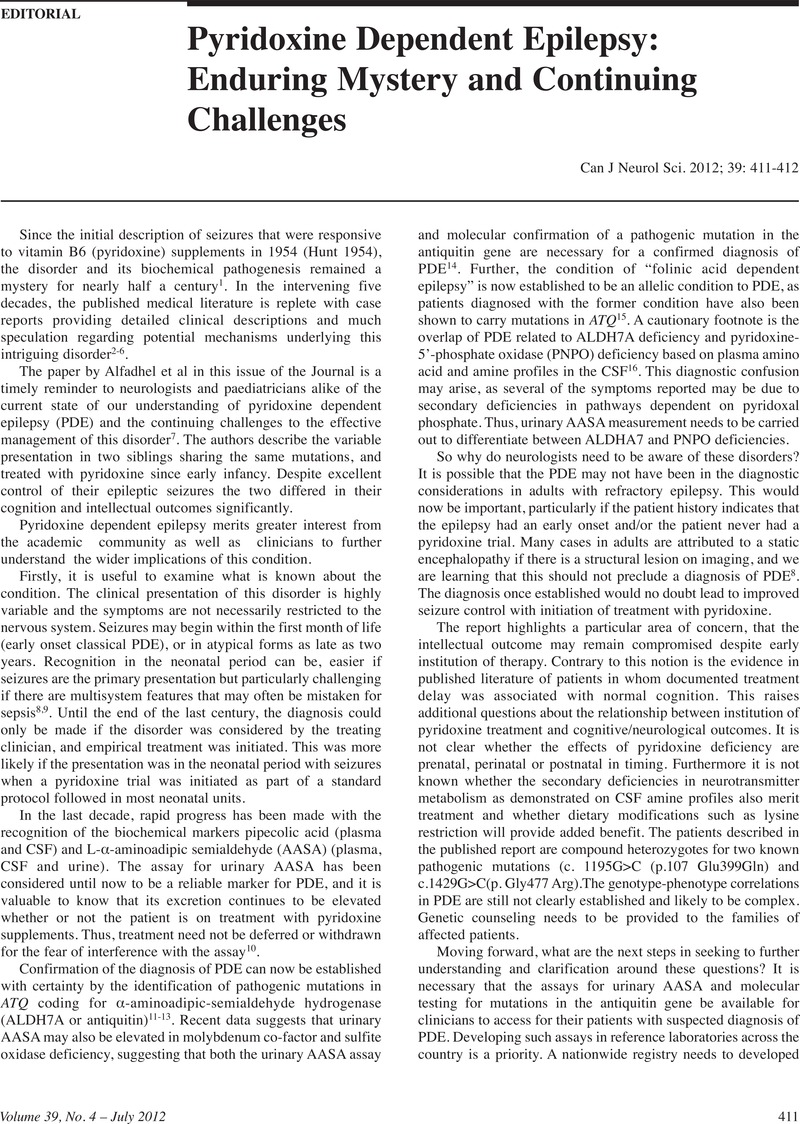No CrossRef data available.
Article contents
Pyridoxine Dependent Epilepsy: Enduring Mystery and Continuing Challenges
Published online by Cambridge University Press: 02 December 2014
Abstract
An abstract is not available for this content so a preview has been provided. As you have access to this content, a full PDF is available via the ‘Save PDF’ action button.

- Type
- Editorial
- Information
- Copyright
- Copyright © The Canadian Journal of Neurological 2012
References
1.Hunt, AD Jr., Stokes, J Jr., Mc, CW, Stroud, HH.Pyridoxine dependency: report of a case of intractable convulsions in an infant controlled by pyridoxine. Pediatrics. 1954;13:140–5.CrossRefGoogle Scholar
2.Goto, T, Matsuo, N, Takahashi, T.CSF glutamate/GABA concentrations in pyridoxine-dependent seizures: etiology of pyridoxine-dependent seizures and the mechanisms of pyridoxine action in seizure control. Brain Dev. 2001;23:24–9.Google Scholar
3.Baxter, P.Epidemiology of pyridoxine dependent and pyridoxine responsive seizures in the UK. Arch Dis Child. 1999;81:431–3.CrossRefGoogle ScholarPubMed
4.Baxter, P, Griffiths, P, Kelly, T, Gardner-Medwin, D.Pyridoxine-dependent seizures: demographic, clinical, MRI and psychometric features, and effect of dose on intelligence quotient. Dev Med Child Neurol. 1996;38:998–1006.Google Scholar
5.Gospe, SM Jr., Olin, KL, Keen, CL.Reduced GABA synthesis in pyridoxine-dependent seizures. Lancet. 1994;343:1133–4.Google Scholar
6.Bankier, A, Turner, M, Hopkins, IJ.Pyridoxine dependent seizures-a wider clinical spectrum. Arch Dis Child. 1983;58:415–18.CrossRefGoogle ScholarPubMed
7.Alfadhel, M, Sirrs, S, Waters, PJ, et al.Variability of phenotype in two sisters with pyridoxine dependent epilepsy. Can J Neurol Sci. 2012;39(4):516–19.CrossRefGoogle ScholarPubMed
8.Mills, PB, Footitt, EJ, Mills, KA, et al.Genotypic and phenotypic spectrum of pyridoxine-dependent epilepsy (ALDH7A1 deficiency). Brain. 2010;133:2148–59.Google Scholar
9.Schmitt, B, Baumgartner, M, Mills, PB, et al.Seizures and paroxysmal events: symptoms pointing to the diagnosis of pyridoxine-dependent epilepsy and pyridoxine phosphate oxidase deficiency. Dev Med Child Neurol. 2010;52:e133–42.Google Scholar
10.Stockler, S, Plecko, B, Gospe, SM Jr., et al.Pyridoxine dependent epilepsy and antiquitin deficiency: clinical and molecular characteristics and recommendations for diagnosis, treatment and follow-up. Mol Genet Metab. 2011;104:48–60.Google Scholar
11.Mills, PB, Struys, E, Jakobs, C, et al.Mutations in antiquitin in individuals with pyridoxine-dependent seizures. Nat Med. 2006;12:307–9.Google Scholar
12.Plecko, B, Hikel, C, Korenke, GC, et al.Pipecolic acid as a diagnostic marker of pyridoxine-dependent epilepsy. Neuropediatrics. 2005;36:200–5.Google Scholar
13.Plecko, B, Stockler-Ipsiroglu, S, Paschke, E, Erwa, W, Struys, EA, Jakobs, C.Pipecolic acid elevation in plasma and cerebrospinal fluid of two patients with pyridoxine-dependent epilepsy. Ann Neurol. 2000;48:121–5.Google Scholar
14.Mills, PB, Footitt, EJ, Ceyhan, S, et al.Urinary AASA excretion is elevated in patients with molybdenum cofactor deficiency and isolated sulphite oxidase deficiency. J Inherit Metab Dis. 2012 - [in press].Google Scholar
15.Gallagher, RC, Van Hove, JL, Scharer, G, et al.Folinic acid-responsive seizures are identical to pyridoxine-dependent epilepsy. Ann Neurol. 2009;65:550–6.CrossRefGoogle ScholarPubMed
16.Hoffmann, GF, Schmitt, B, Windfuhr, M, et al.Pyridoxal 5’-phosphate may be curative in early-onset epileptic encephalopathy. J Inherit Metab Dis. 2007;30:96–9.Google Scholar


